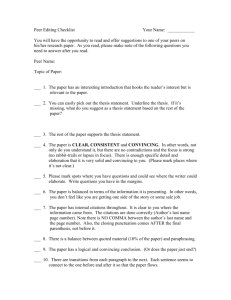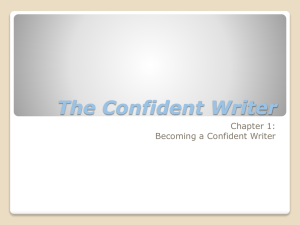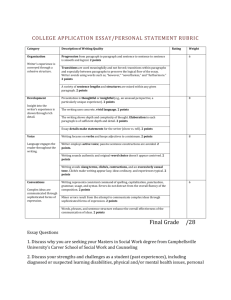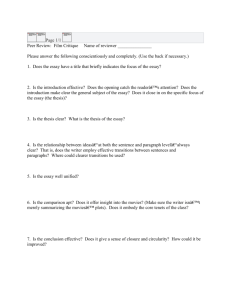peer critique form
advertisement
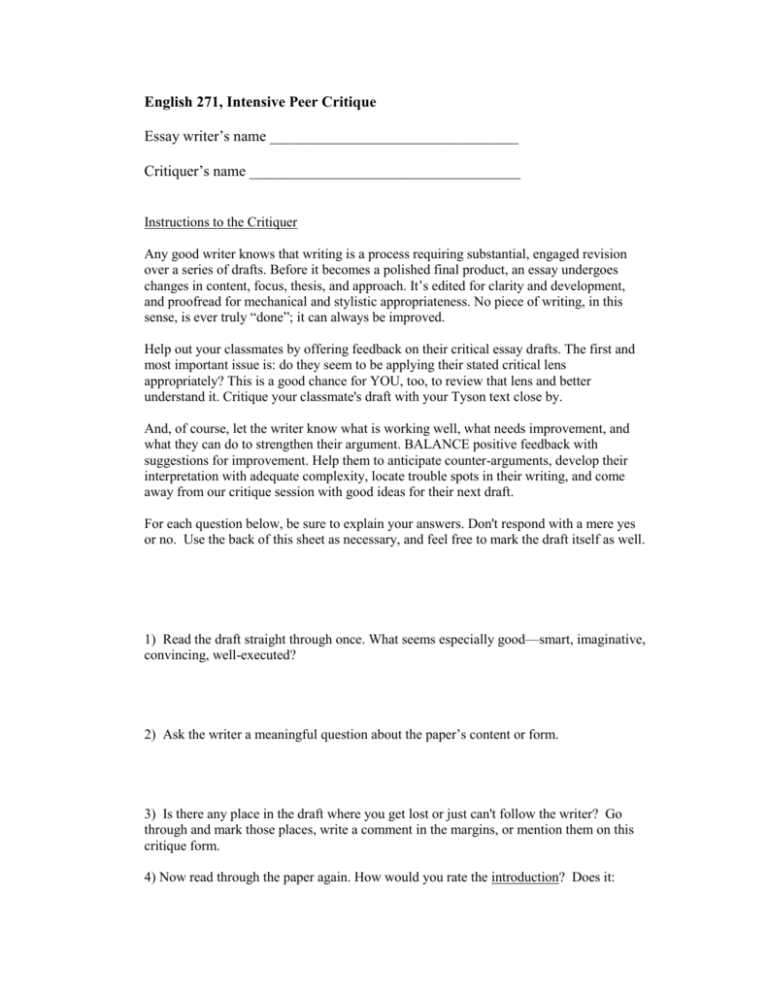
English 271, Intensive Peer Critique Essay writer’s name _________________________________ Critiquer’s name ____________________________________ Instructions to the Critiquer Any good writer knows that writing is a process requiring substantial, engaged revision over a series of drafts. Before it becomes a polished final product, an essay undergoes changes in content, focus, thesis, and approach. It’s edited for clarity and development, and proofread for mechanical and stylistic appropriateness. No piece of writing, in this sense, is ever truly “done”; it can always be improved. Help out your classmates by offering feedback on their critical essay drafts. The first and most important issue is: do they seem to be applying their stated critical lens appropriately? This is a good chance for YOU, too, to review that lens and better understand it. Critique your classmate's draft with your Tyson text close by. And, of course, let the writer know what is working well, what needs improvement, and what they can do to strengthen their argument. BALANCE positive feedback with suggestions for improvement. Help them to anticipate counter-arguments, develop their interpretation with adequate complexity, locate trouble spots in their writing, and come away from our critique session with good ideas for their next draft. For each question below, be sure to explain your answers. Don't respond with a mere yes or no. Use the back of this sheet as necessary, and feel free to mark the draft itself as well. 1) Read the draft straight through once. What seems especially good—smart, imaginative, convincing, well-executed? 2) Ask the writer a meaningful question about the paper’s content or form. 3) Is there any place in the draft where you get lost or just can't follow the writer? Go through and mark those places, write a comment in the margins, or mention them on this critique form. 4) Now read through the paper again. How would you rate the introduction? Does it: a. Make clear what critical lens is being used and what work is being analyzed? (This should also be evident in the title.) If not, explain. b) Present a clear thesis (a central, debatable claim or assertion) about the work in question? Also: is that thesis appropriate to the critical lens being used? If not, explain. c) Does the intro. engage you and make you want to continue reading? If not, explain. 5) Is the thesis consistent throughout the piece or does some other point seem to replace it? Is the thesis clearly affirmed throughout the paper, or does it seem to vanish, get forgotten? 6) Is each paragraph: a) Clearly focused around a single claim or assertion? b) Adequately developed? That is, is there plenty of specific reasoning and detail to support the paragraph’s main claim? (The writer should be supporting her or his claims with examples, quotes, details, reasons.) 7) Are there helpful transitions from paragraph to paragraph, so that the reader can follow the writer’s reasoning without getting lost or confused? 8) Does each paragraph in some way clearly relate back to the paper’s central claim or thesis—or does the thesis sort of get forgotten as the essay proceeds? 9) Has the writer sufficiently anticipated and refuted any complaints which might be made about their thesis? I.e., can you think of arguments AGAINST this writer's thesis? Help them out by debating their argument a bit. Challenge their thesis. Be a meanie. 2 10) Can you think of additional arguments, claims, evidence etc. FOR the writer's argument? Be a sweetie. 11) Has this writer presented the argument in an engaging, compelling style? Has she or he made use of varied sentence length and structure and appropriate diction? Do you ENJOY reading it? 12) Are sentences concise and clear? (It’s easy, when applying a brand-new theory for the first time, for a writer’s style and especially clarity to break down in spots. It happens to everyone. Help the writer out with this.) 13) Does the draft suffer from mechanical errors or lapses? Mention any specific errors you found here or on the draft itself (just mark them—don’t actually correct them). Consider spelling, punctuation, and grammar, as well as manuscript format. (Remember that you should all be using MLA-style format for titling, margins, pagination etc. Links to formatting help are located in our online class library; see especially the link to BedfordSt.Martin's Research and Documentation.) 14) Are good paraphrases and quotations provided in the essay? Are these items properly documented according to MLA format? Are quotations smoothly integrated with leadins, and is the draft free of any possible plagiarism (accidental or otherwise)? 15) Does this writer properly apply basic rules for writing about literature? (See the Power Point document titled, "Writing Your Critical Essays," in Blackboard "Course Documents" to review these basic conventions. 16) What are you left thinking at the end of the paper? Does the essay finish with a satisfying conclusion which reaffirms the thesis and leaves you feeling convinced? Write a comment about this to the writer. 17) Now address the real meat of this assignment: how well is the writer applying the 3 theory in question? a) Is there any place where the writer’s understanding of the theory seems faulty? b) Does the writer provide any theoretical background in spots to maintain lucidity or help the reader follow the essay’s reasoning? (It might be necessary for the writer to actually talk about the theory in question at times, though the essay shouldn’t go overboard with this. Assume your readers may sometimes need help remembering and understanding the theory, but assume also that the reader is very familiar with it already.) c) Important: does the draft clearly apply information from Tyson and class discussion/lecture? Are one or more of Tyson's chapter questions being applied in some way? Remember that a thesis statement for these essays might well be an answer to one of those questions. 18) What final comments or suggestions would you like to make? THANK YOU! 4


